Report: Micro and Macro Forces Affecting Hospitality Performance
VerifiedAdded on 2022/10/19
|10
|1993
|496
Report
AI Summary
This report examines the significant influence of micro and macro forces on the performance and expansion of the tourism and hospitality sectors. It begins by analyzing the effects of micro-environmental forces, such as customer preferences and competitive pressures, on major hotel chains like Hilton and JW Marriott, particularly in the context of globalization and market competition. The report then delves into macro-environmental factors, including political instability and government policies, and their impact on tourism in regions like China, Hong Kong, and Taiwan. The analysis highlights how geopolitical tensions and internal conflicts can severely disrupt the industry. Furthermore, the report provides strategic recommendations for businesses to navigate these challenges, suggesting measures to mitigate risks and capitalize on opportunities, such as strategic partnerships and proactive market strategies, to ensure sustainable growth and maintain a competitive edge in the dynamic hospitality landscape. The report concludes with a synthesis of key findings and reiterates the critical role of adapting to both micro and macro forces for long-term success.
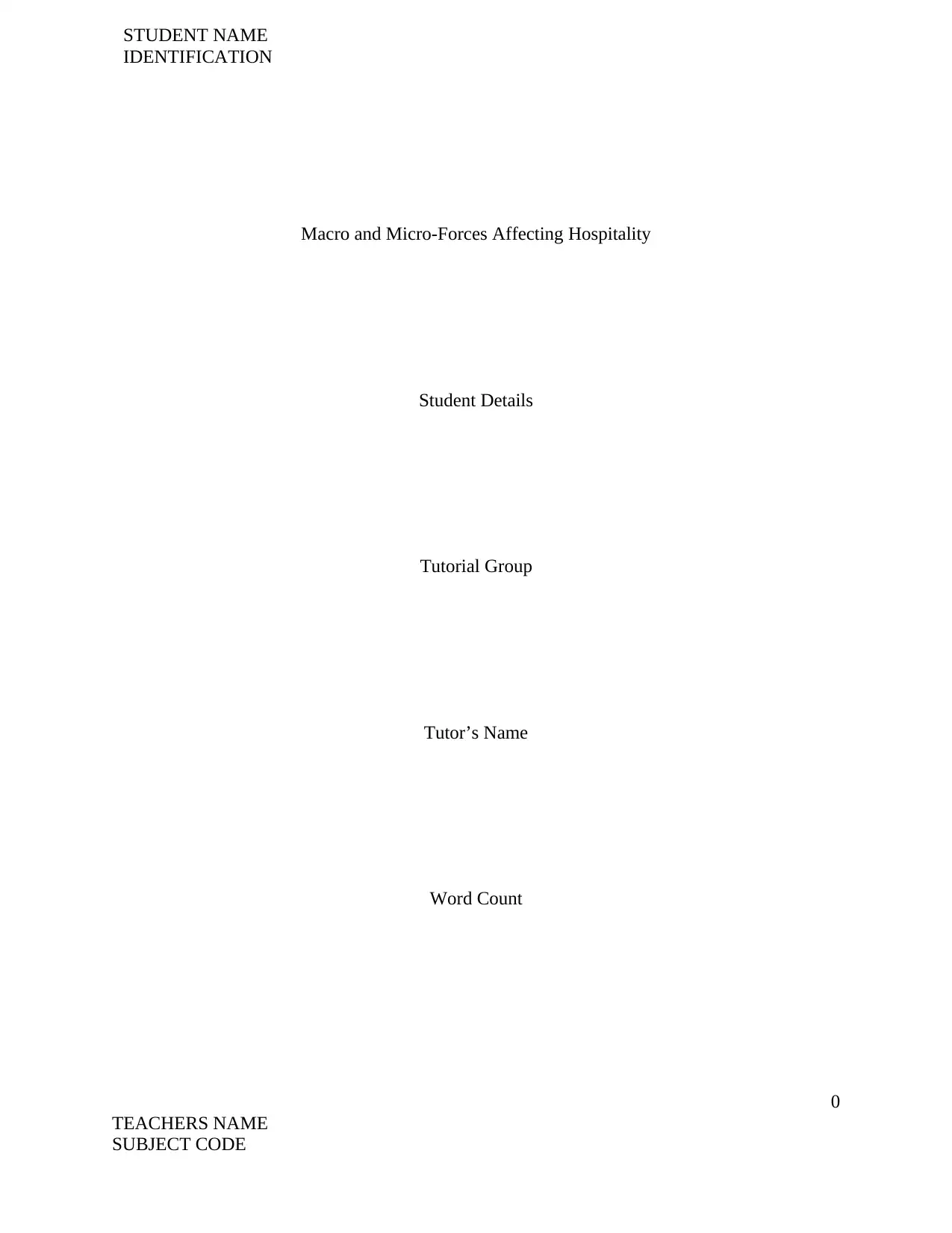
STUDENT NAME
IDENTIFICATION
Macro and Micro-Forces Affecting Hospitality
Student Details
Tutorial Group
Tutor’s Name
Word Count
0
TEACHERS NAME
SUBJECT CODE
IDENTIFICATION
Macro and Micro-Forces Affecting Hospitality
Student Details
Tutorial Group
Tutor’s Name
Word Count
0
TEACHERS NAME
SUBJECT CODE
Paraphrase This Document
Need a fresh take? Get an instant paraphrase of this document with our AI Paraphraser
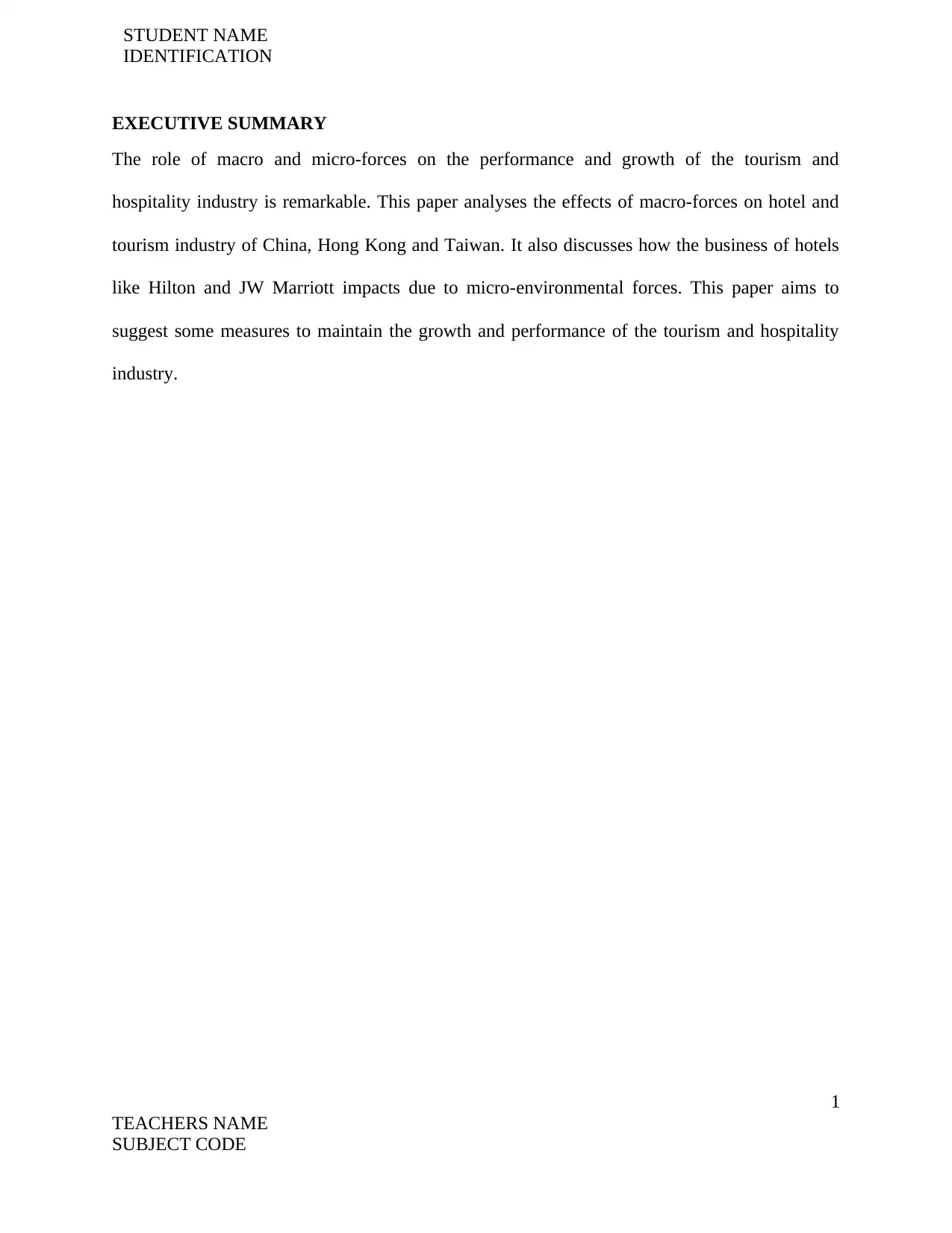
STUDENT NAME
IDENTIFICATION
EXECUTIVE SUMMARY
The role of macro and micro-forces on the performance and growth of the tourism and
hospitality industry is remarkable. This paper analyses the effects of macro-forces on hotel and
tourism industry of China, Hong Kong and Taiwan. It also discusses how the business of hotels
like Hilton and JW Marriott impacts due to micro-environmental forces. This paper aims to
suggest some measures to maintain the growth and performance of the tourism and hospitality
industry.
1
TEACHERS NAME
SUBJECT CODE
IDENTIFICATION
EXECUTIVE SUMMARY
The role of macro and micro-forces on the performance and growth of the tourism and
hospitality industry is remarkable. This paper analyses the effects of macro-forces on hotel and
tourism industry of China, Hong Kong and Taiwan. It also discusses how the business of hotels
like Hilton and JW Marriott impacts due to micro-environmental forces. This paper aims to
suggest some measures to maintain the growth and performance of the tourism and hospitality
industry.
1
TEACHERS NAME
SUBJECT CODE
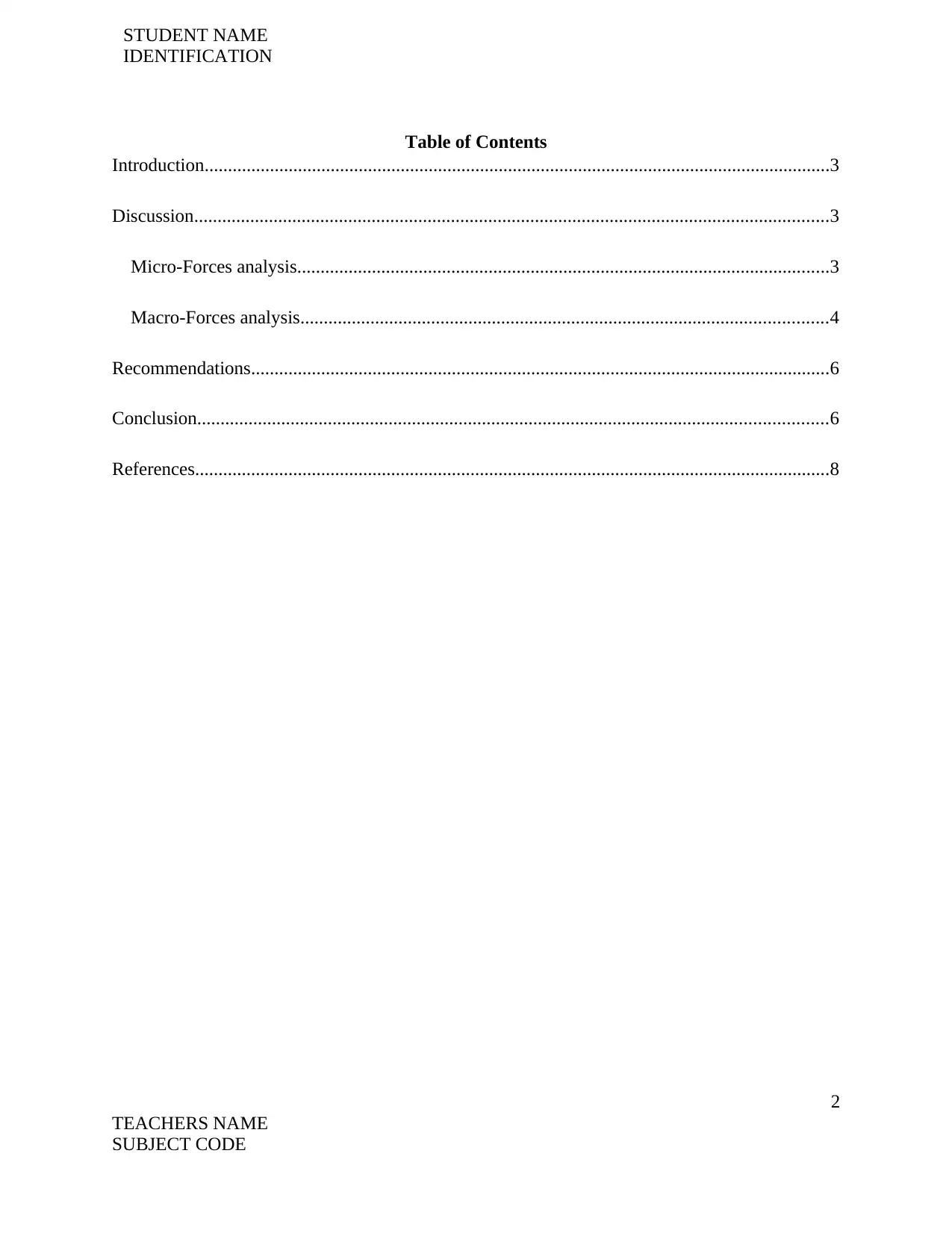
STUDENT NAME
IDENTIFICATION
Table of Contents
Introduction......................................................................................................................................3
Discussion........................................................................................................................................3
Micro-Forces analysis..................................................................................................................3
Macro-Forces analysis.................................................................................................................4
Recommendations............................................................................................................................6
Conclusion.......................................................................................................................................6
References........................................................................................................................................8
2
TEACHERS NAME
SUBJECT CODE
IDENTIFICATION
Table of Contents
Introduction......................................................................................................................................3
Discussion........................................................................................................................................3
Micro-Forces analysis..................................................................................................................3
Macro-Forces analysis.................................................................................................................4
Recommendations............................................................................................................................6
Conclusion.......................................................................................................................................6
References........................................................................................................................................8
2
TEACHERS NAME
SUBJECT CODE
⊘ This is a preview!⊘
Do you want full access?
Subscribe today to unlock all pages.

Trusted by 1+ million students worldwide
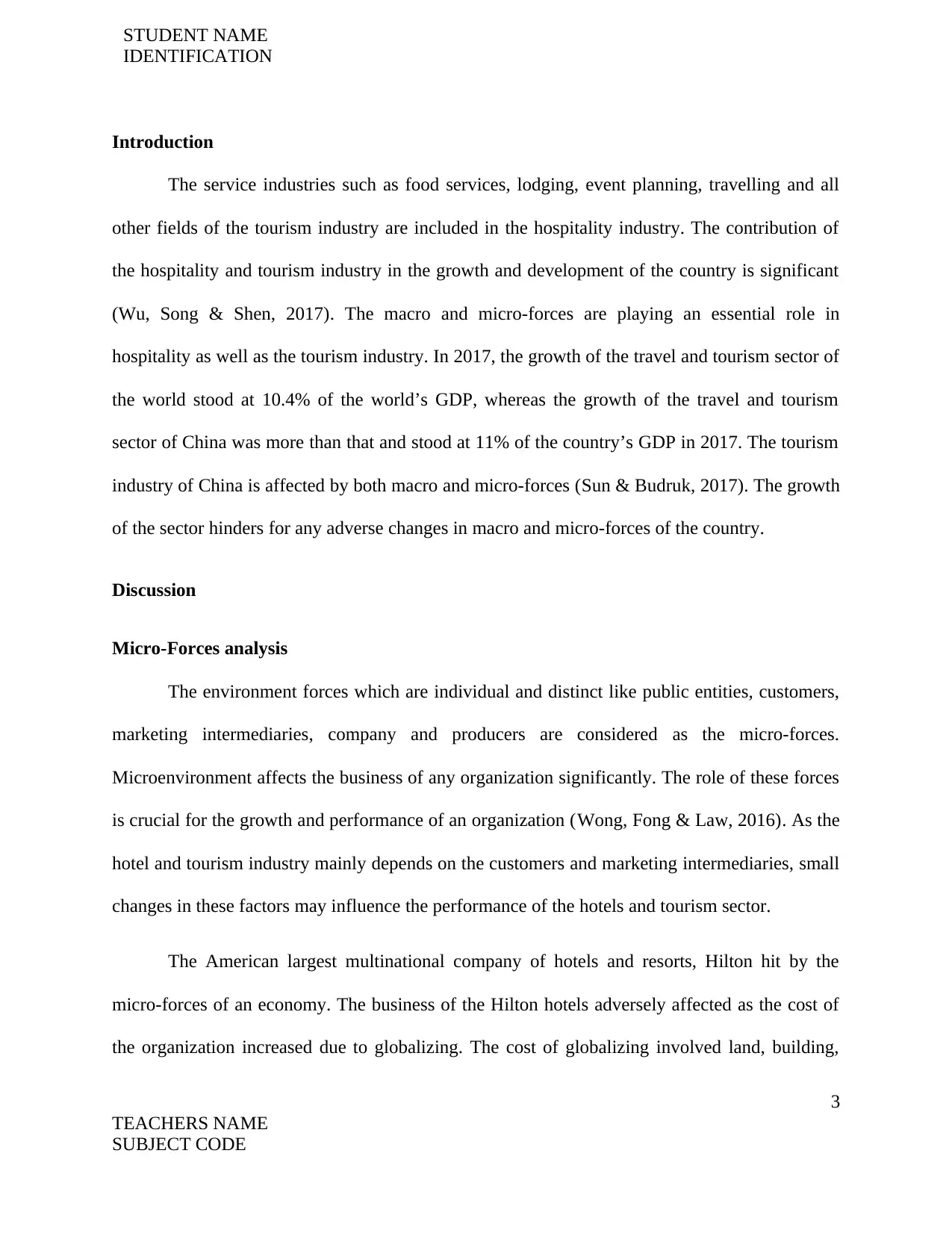
STUDENT NAME
IDENTIFICATION
Introduction
The service industries such as food services, lodging, event planning, travelling and all
other fields of the tourism industry are included in the hospitality industry. The contribution of
the hospitality and tourism industry in the growth and development of the country is significant
(Wu, Song & Shen, 2017). The macro and micro-forces are playing an essential role in
hospitality as well as the tourism industry. In 2017, the growth of the travel and tourism sector of
the world stood at 10.4% of the world’s GDP, whereas the growth of the travel and tourism
sector of China was more than that and stood at 11% of the country’s GDP in 2017. The tourism
industry of China is affected by both macro and micro-forces (Sun & Budruk, 2017). The growth
of the sector hinders for any adverse changes in macro and micro-forces of the country.
Discussion
Micro-Forces analysis
The environment forces which are individual and distinct like public entities, customers,
marketing intermediaries, company and producers are considered as the micro-forces.
Microenvironment affects the business of any organization significantly. The role of these forces
is crucial for the growth and performance of an organization (Wong, Fong & Law, 2016). As the
hotel and tourism industry mainly depends on the customers and marketing intermediaries, small
changes in these factors may influence the performance of the hotels and tourism sector.
The American largest multinational company of hotels and resorts, Hilton hit by the
micro-forces of an economy. The business of the Hilton hotels adversely affected as the cost of
the organization increased due to globalizing. The cost of globalizing involved land, building,
3
TEACHERS NAME
SUBJECT CODE
IDENTIFICATION
Introduction
The service industries such as food services, lodging, event planning, travelling and all
other fields of the tourism industry are included in the hospitality industry. The contribution of
the hospitality and tourism industry in the growth and development of the country is significant
(Wu, Song & Shen, 2017). The macro and micro-forces are playing an essential role in
hospitality as well as the tourism industry. In 2017, the growth of the travel and tourism sector of
the world stood at 10.4% of the world’s GDP, whereas the growth of the travel and tourism
sector of China was more than that and stood at 11% of the country’s GDP in 2017. The tourism
industry of China is affected by both macro and micro-forces (Sun & Budruk, 2017). The growth
of the sector hinders for any adverse changes in macro and micro-forces of the country.
Discussion
Micro-Forces analysis
The environment forces which are individual and distinct like public entities, customers,
marketing intermediaries, company and producers are considered as the micro-forces.
Microenvironment affects the business of any organization significantly. The role of these forces
is crucial for the growth and performance of an organization (Wong, Fong & Law, 2016). As the
hotel and tourism industry mainly depends on the customers and marketing intermediaries, small
changes in these factors may influence the performance of the hotels and tourism sector.
The American largest multinational company of hotels and resorts, Hilton hit by the
micro-forces of an economy. The business of the Hilton hotels adversely affected as the cost of
the organization increased due to globalizing. The cost of globalizing involved land, building,
3
TEACHERS NAME
SUBJECT CODE
Paraphrase This Document
Need a fresh take? Get an instant paraphrase of this document with our AI Paraphraser
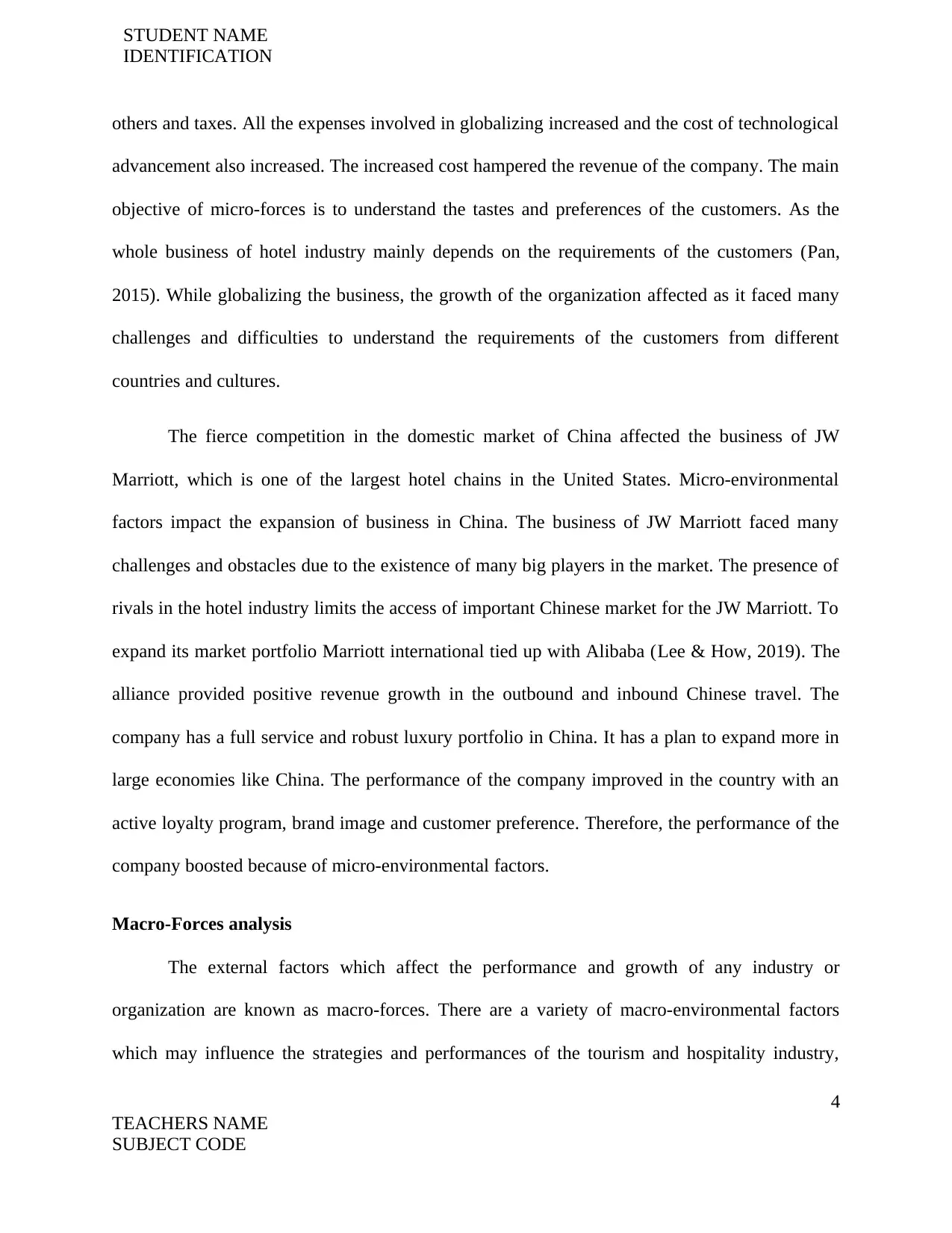
STUDENT NAME
IDENTIFICATION
others and taxes. All the expenses involved in globalizing increased and the cost of technological
advancement also increased. The increased cost hampered the revenue of the company. The main
objective of micro-forces is to understand the tastes and preferences of the customers. As the
whole business of hotel industry mainly depends on the requirements of the customers (Pan,
2015). While globalizing the business, the growth of the organization affected as it faced many
challenges and difficulties to understand the requirements of the customers from different
countries and cultures.
The fierce competition in the domestic market of China affected the business of JW
Marriott, which is one of the largest hotel chains in the United States. Micro-environmental
factors impact the expansion of business in China. The business of JW Marriott faced many
challenges and obstacles due to the existence of many big players in the market. The presence of
rivals in the hotel industry limits the access of important Chinese market for the JW Marriott. To
expand its market portfolio Marriott international tied up with Alibaba (Lee & How, 2019). The
alliance provided positive revenue growth in the outbound and inbound Chinese travel. The
company has a full service and robust luxury portfolio in China. It has a plan to expand more in
large economies like China. The performance of the company improved in the country with an
active loyalty program, brand image and customer preference. Therefore, the performance of the
company boosted because of micro-environmental factors.
Macro-Forces analysis
The external factors which affect the performance and growth of any industry or
organization are known as macro-forces. There are a variety of macro-environmental factors
which may influence the strategies and performances of the tourism and hospitality industry,
4
TEACHERS NAME
SUBJECT CODE
IDENTIFICATION
others and taxes. All the expenses involved in globalizing increased and the cost of technological
advancement also increased. The increased cost hampered the revenue of the company. The main
objective of micro-forces is to understand the tastes and preferences of the customers. As the
whole business of hotel industry mainly depends on the requirements of the customers (Pan,
2015). While globalizing the business, the growth of the organization affected as it faced many
challenges and difficulties to understand the requirements of the customers from different
countries and cultures.
The fierce competition in the domestic market of China affected the business of JW
Marriott, which is one of the largest hotel chains in the United States. Micro-environmental
factors impact the expansion of business in China. The business of JW Marriott faced many
challenges and obstacles due to the existence of many big players in the market. The presence of
rivals in the hotel industry limits the access of important Chinese market for the JW Marriott. To
expand its market portfolio Marriott international tied up with Alibaba (Lee & How, 2019). The
alliance provided positive revenue growth in the outbound and inbound Chinese travel. The
company has a full service and robust luxury portfolio in China. It has a plan to expand more in
large economies like China. The performance of the company improved in the country with an
active loyalty program, brand image and customer preference. Therefore, the performance of the
company boosted because of micro-environmental factors.
Macro-Forces analysis
The external factors which affect the performance and growth of any industry or
organization are known as macro-forces. There are a variety of macro-environmental factors
which may influence the strategies and performances of the tourism and hospitality industry,
4
TEACHERS NAME
SUBJECT CODE
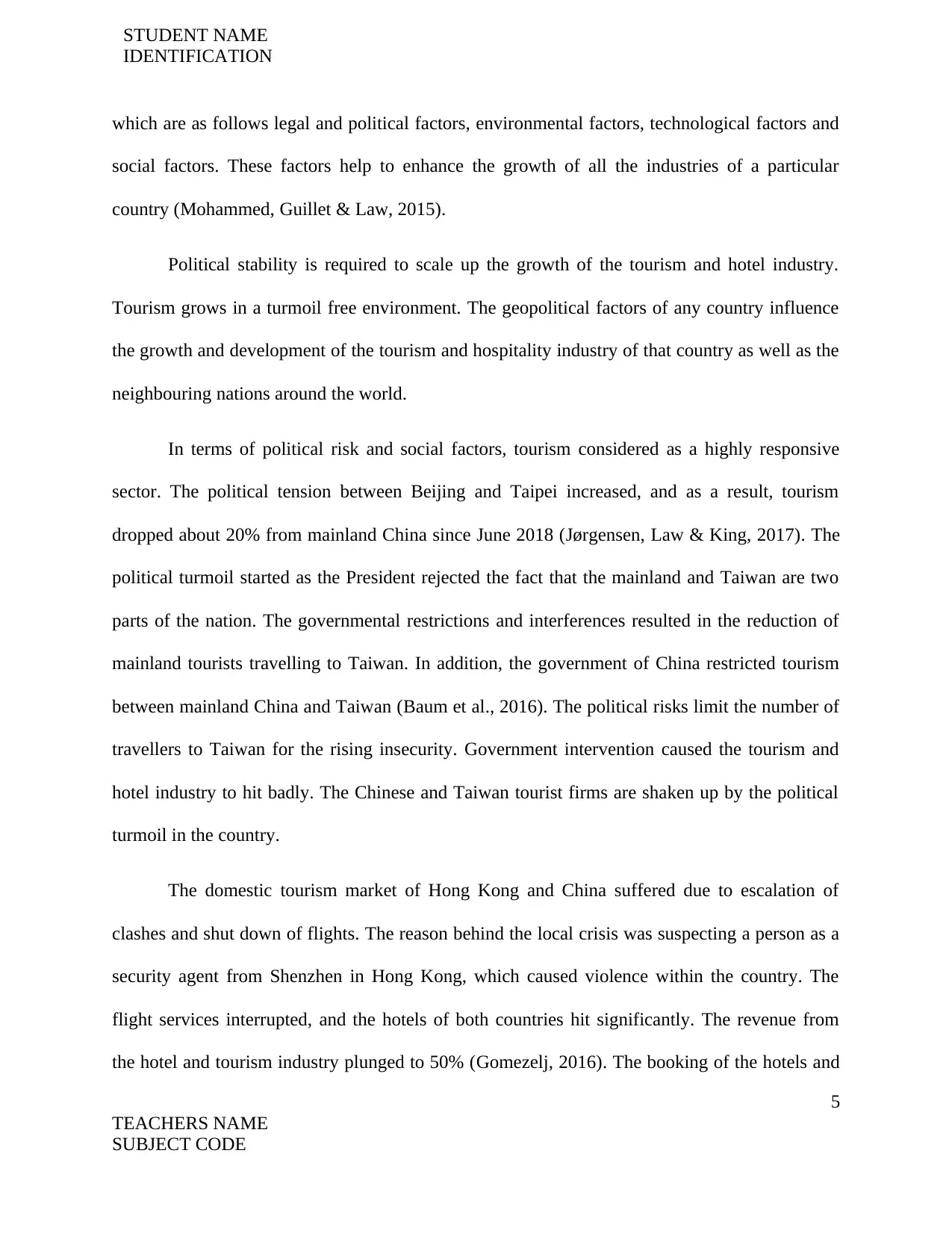
STUDENT NAME
IDENTIFICATION
which are as follows legal and political factors, environmental factors, technological factors and
social factors. These factors help to enhance the growth of all the industries of a particular
country (Mohammed, Guillet & Law, 2015).
Political stability is required to scale up the growth of the tourism and hotel industry.
Tourism grows in a turmoil free environment. The geopolitical factors of any country influence
the growth and development of the tourism and hospitality industry of that country as well as the
neighbouring nations around the world.
In terms of political risk and social factors, tourism considered as a highly responsive
sector. The political tension between Beijing and Taipei increased, and as a result, tourism
dropped about 20% from mainland China since June 2018 (Jørgensen, Law & King, 2017). The
political turmoil started as the President rejected the fact that the mainland and Taiwan are two
parts of the nation. The governmental restrictions and interferences resulted in the reduction of
mainland tourists travelling to Taiwan. In addition, the government of China restricted tourism
between mainland China and Taiwan (Baum et al., 2016). The political risks limit the number of
travellers to Taiwan for the rising insecurity. Government intervention caused the tourism and
hotel industry to hit badly. The Chinese and Taiwan tourist firms are shaken up by the political
turmoil in the country.
The domestic tourism market of Hong Kong and China suffered due to escalation of
clashes and shut down of flights. The reason behind the local crisis was suspecting a person as a
security agent from Shenzhen in Hong Kong, which caused violence within the country. The
flight services interrupted, and the hotels of both countries hit significantly. The revenue from
the hotel and tourism industry plunged to 50% (Gomezelj, 2016). The booking of the hotels and
5
TEACHERS NAME
SUBJECT CODE
IDENTIFICATION
which are as follows legal and political factors, environmental factors, technological factors and
social factors. These factors help to enhance the growth of all the industries of a particular
country (Mohammed, Guillet & Law, 2015).
Political stability is required to scale up the growth of the tourism and hotel industry.
Tourism grows in a turmoil free environment. The geopolitical factors of any country influence
the growth and development of the tourism and hospitality industry of that country as well as the
neighbouring nations around the world.
In terms of political risk and social factors, tourism considered as a highly responsive
sector. The political tension between Beijing and Taipei increased, and as a result, tourism
dropped about 20% from mainland China since June 2018 (Jørgensen, Law & King, 2017). The
political turmoil started as the President rejected the fact that the mainland and Taiwan are two
parts of the nation. The governmental restrictions and interferences resulted in the reduction of
mainland tourists travelling to Taiwan. In addition, the government of China restricted tourism
between mainland China and Taiwan (Baum et al., 2016). The political risks limit the number of
travellers to Taiwan for the rising insecurity. Government intervention caused the tourism and
hotel industry to hit badly. The Chinese and Taiwan tourist firms are shaken up by the political
turmoil in the country.
The domestic tourism market of Hong Kong and China suffered due to escalation of
clashes and shut down of flights. The reason behind the local crisis was suspecting a person as a
security agent from Shenzhen in Hong Kong, which caused violence within the country. The
flight services interrupted, and the hotels of both countries hit significantly. The revenue from
the hotel and tourism industry plunged to 50% (Gomezelj, 2016). The booking of the hotels and
5
TEACHERS NAME
SUBJECT CODE
⊘ This is a preview!⊘
Do you want full access?
Subscribe today to unlock all pages.

Trusted by 1+ million students worldwide
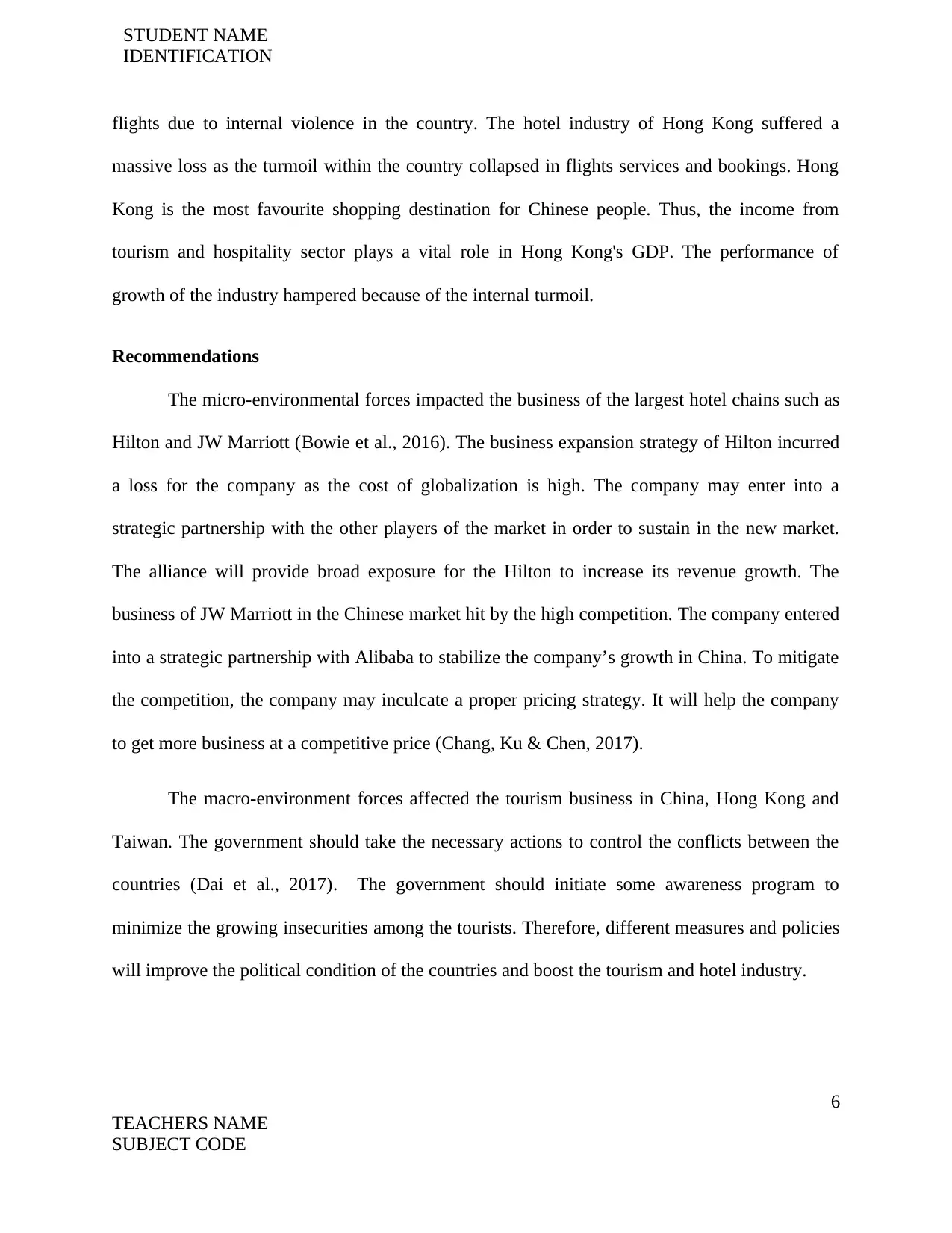
STUDENT NAME
IDENTIFICATION
flights due to internal violence in the country. The hotel industry of Hong Kong suffered a
massive loss as the turmoil within the country collapsed in flights services and bookings. Hong
Kong is the most favourite shopping destination for Chinese people. Thus, the income from
tourism and hospitality sector plays a vital role in Hong Kong's GDP. The performance of
growth of the industry hampered because of the internal turmoil.
Recommendations
The micro-environmental forces impacted the business of the largest hotel chains such as
Hilton and JW Marriott (Bowie et al., 2016). The business expansion strategy of Hilton incurred
a loss for the company as the cost of globalization is high. The company may enter into a
strategic partnership with the other players of the market in order to sustain in the new market.
The alliance will provide broad exposure for the Hilton to increase its revenue growth. The
business of JW Marriott in the Chinese market hit by the high competition. The company entered
into a strategic partnership with Alibaba to stabilize the company’s growth in China. To mitigate
the competition, the company may inculcate a proper pricing strategy. It will help the company
to get more business at a competitive price (Chang, Ku & Chen, 2017).
The macro-environment forces affected the tourism business in China, Hong Kong and
Taiwan. The government should take the necessary actions to control the conflicts between the
countries (Dai et al., 2017). The government should initiate some awareness program to
minimize the growing insecurities among the tourists. Therefore, different measures and policies
will improve the political condition of the countries and boost the tourism and hotel industry.
6
TEACHERS NAME
SUBJECT CODE
IDENTIFICATION
flights due to internal violence in the country. The hotel industry of Hong Kong suffered a
massive loss as the turmoil within the country collapsed in flights services and bookings. Hong
Kong is the most favourite shopping destination for Chinese people. Thus, the income from
tourism and hospitality sector plays a vital role in Hong Kong's GDP. The performance of
growth of the industry hampered because of the internal turmoil.
Recommendations
The micro-environmental forces impacted the business of the largest hotel chains such as
Hilton and JW Marriott (Bowie et al., 2016). The business expansion strategy of Hilton incurred
a loss for the company as the cost of globalization is high. The company may enter into a
strategic partnership with the other players of the market in order to sustain in the new market.
The alliance will provide broad exposure for the Hilton to increase its revenue growth. The
business of JW Marriott in the Chinese market hit by the high competition. The company entered
into a strategic partnership with Alibaba to stabilize the company’s growth in China. To mitigate
the competition, the company may inculcate a proper pricing strategy. It will help the company
to get more business at a competitive price (Chang, Ku & Chen, 2017).
The macro-environment forces affected the tourism business in China, Hong Kong and
Taiwan. The government should take the necessary actions to control the conflicts between the
countries (Dai et al., 2017). The government should initiate some awareness program to
minimize the growing insecurities among the tourists. Therefore, different measures and policies
will improve the political condition of the countries and boost the tourism and hotel industry.
6
TEACHERS NAME
SUBJECT CODE
Paraphrase This Document
Need a fresh take? Get an instant paraphrase of this document with our AI Paraphraser
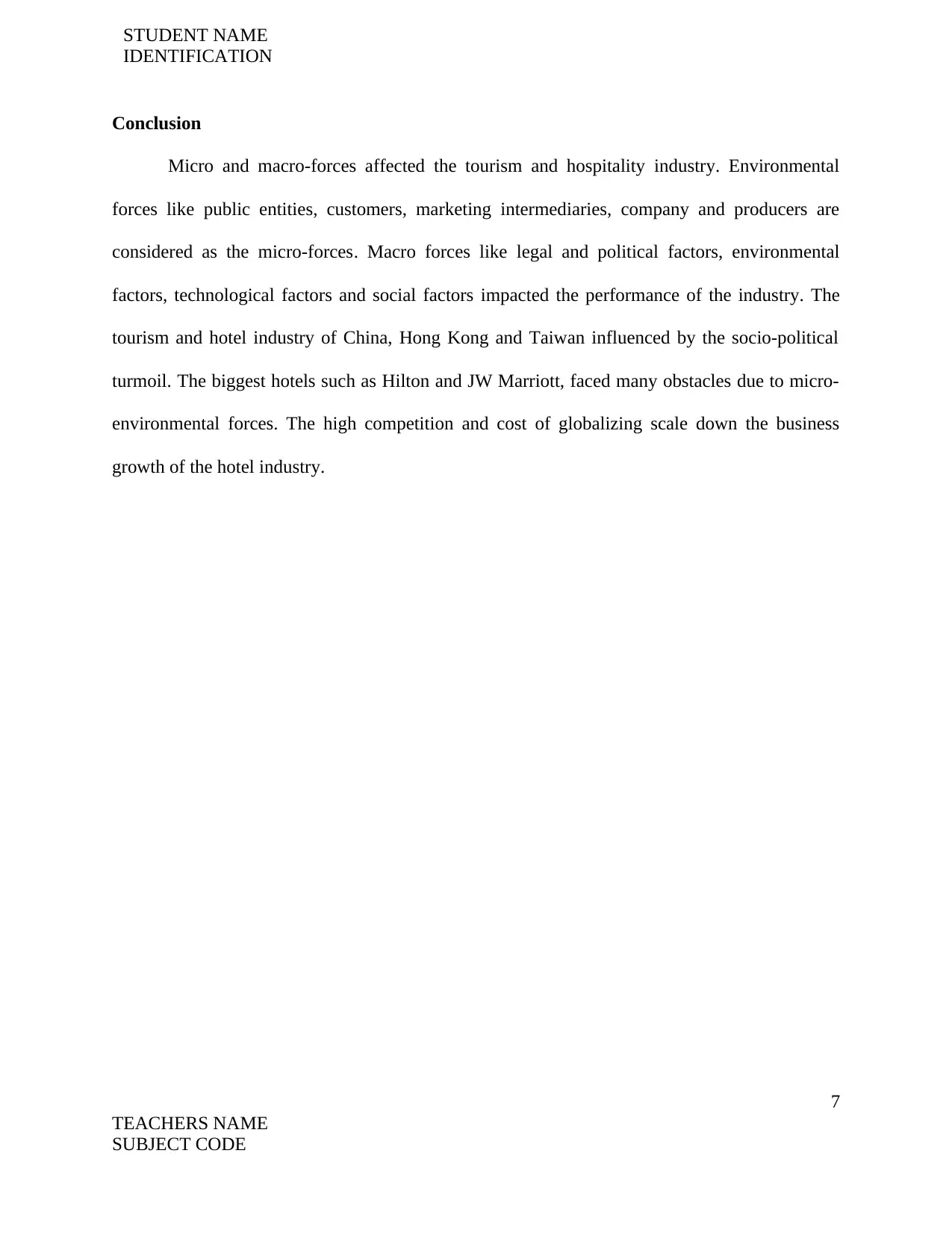
STUDENT NAME
IDENTIFICATION
Conclusion
Micro and macro-forces affected the tourism and hospitality industry. Environmental
forces like public entities, customers, marketing intermediaries, company and producers are
considered as the micro-forces. Macro forces like legal and political factors, environmental
factors, technological factors and social factors impacted the performance of the industry. The
tourism and hotel industry of China, Hong Kong and Taiwan influenced by the socio-political
turmoil. The biggest hotels such as Hilton and JW Marriott, faced many obstacles due to micro-
environmental forces. The high competition and cost of globalizing scale down the business
growth of the hotel industry.
7
TEACHERS NAME
SUBJECT CODE
IDENTIFICATION
Conclusion
Micro and macro-forces affected the tourism and hospitality industry. Environmental
forces like public entities, customers, marketing intermediaries, company and producers are
considered as the micro-forces. Macro forces like legal and political factors, environmental
factors, technological factors and social factors impacted the performance of the industry. The
tourism and hotel industry of China, Hong Kong and Taiwan influenced by the socio-political
turmoil. The biggest hotels such as Hilton and JW Marriott, faced many obstacles due to micro-
environmental forces. The high competition and cost of globalizing scale down the business
growth of the hotel industry.
7
TEACHERS NAME
SUBJECT CODE
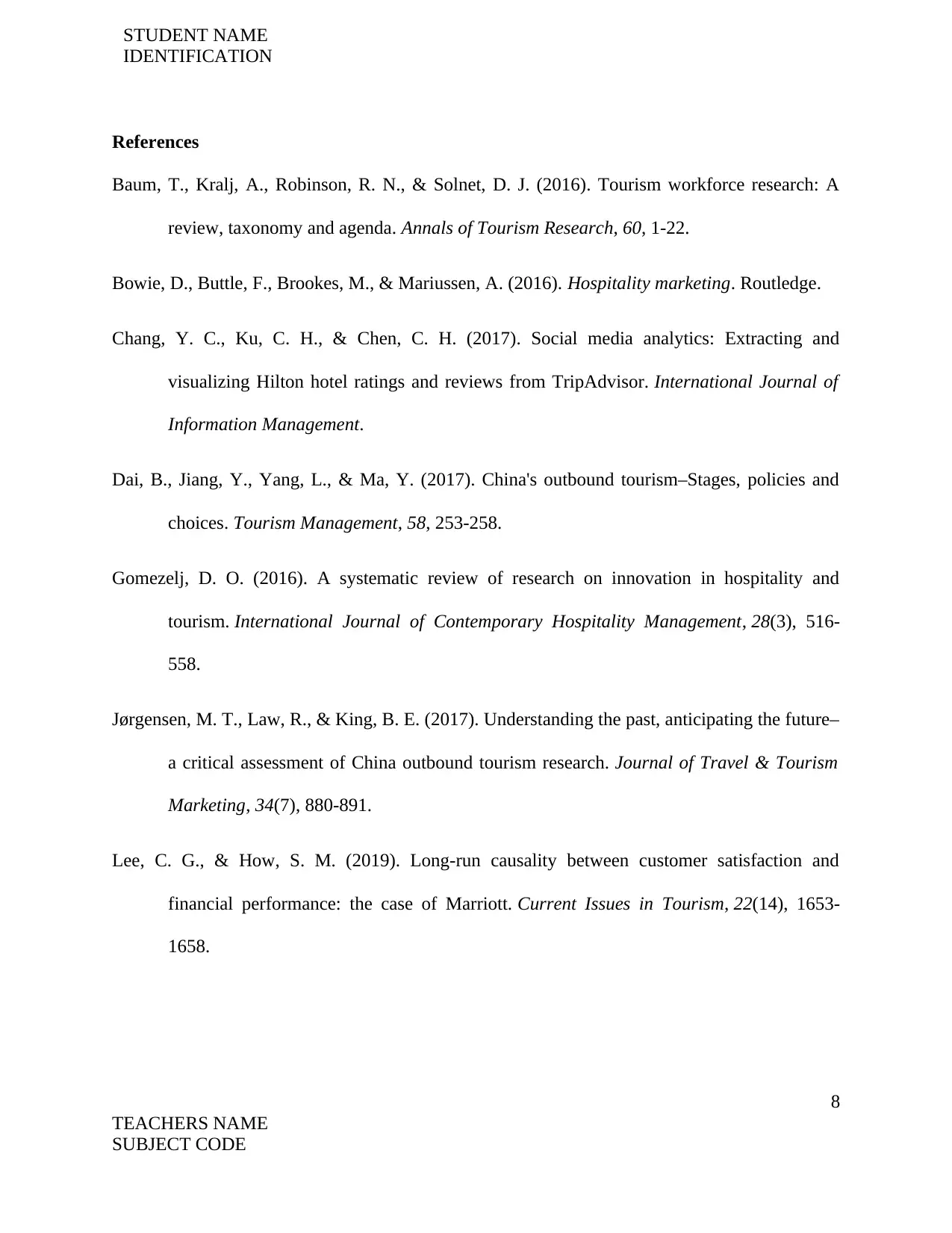
STUDENT NAME
IDENTIFICATION
References
Baum, T., Kralj, A., Robinson, R. N., & Solnet, D. J. (2016). Tourism workforce research: A
review, taxonomy and agenda. Annals of Tourism Research, 60, 1-22.
Bowie, D., Buttle, F., Brookes, M., & Mariussen, A. (2016). Hospitality marketing. Routledge.
Chang, Y. C., Ku, C. H., & Chen, C. H. (2017). Social media analytics: Extracting and
visualizing Hilton hotel ratings and reviews from TripAdvisor. International Journal of
Information Management.
Dai, B., Jiang, Y., Yang, L., & Ma, Y. (2017). China's outbound tourism–Stages, policies and
choices. Tourism Management, 58, 253-258.
Gomezelj, D. O. (2016). A systematic review of research on innovation in hospitality and
tourism. International Journal of Contemporary Hospitality Management, 28(3), 516-
558.
Jørgensen, M. T., Law, R., & King, B. E. (2017). Understanding the past, anticipating the future–
a critical assessment of China outbound tourism research. Journal of Travel & Tourism
Marketing, 34(7), 880-891.
Lee, C. G., & How, S. M. (2019). Long-run causality between customer satisfaction and
financial performance: the case of Marriott. Current Issues in Tourism, 22(14), 1653-
1658.
8
TEACHERS NAME
SUBJECT CODE
IDENTIFICATION
References
Baum, T., Kralj, A., Robinson, R. N., & Solnet, D. J. (2016). Tourism workforce research: A
review, taxonomy and agenda. Annals of Tourism Research, 60, 1-22.
Bowie, D., Buttle, F., Brookes, M., & Mariussen, A. (2016). Hospitality marketing. Routledge.
Chang, Y. C., Ku, C. H., & Chen, C. H. (2017). Social media analytics: Extracting and
visualizing Hilton hotel ratings and reviews from TripAdvisor. International Journal of
Information Management.
Dai, B., Jiang, Y., Yang, L., & Ma, Y. (2017). China's outbound tourism–Stages, policies and
choices. Tourism Management, 58, 253-258.
Gomezelj, D. O. (2016). A systematic review of research on innovation in hospitality and
tourism. International Journal of Contemporary Hospitality Management, 28(3), 516-
558.
Jørgensen, M. T., Law, R., & King, B. E. (2017). Understanding the past, anticipating the future–
a critical assessment of China outbound tourism research. Journal of Travel & Tourism
Marketing, 34(7), 880-891.
Lee, C. G., & How, S. M. (2019). Long-run causality between customer satisfaction and
financial performance: the case of Marriott. Current Issues in Tourism, 22(14), 1653-
1658.
8
TEACHERS NAME
SUBJECT CODE
⊘ This is a preview!⊘
Do you want full access?
Subscribe today to unlock all pages.

Trusted by 1+ million students worldwide
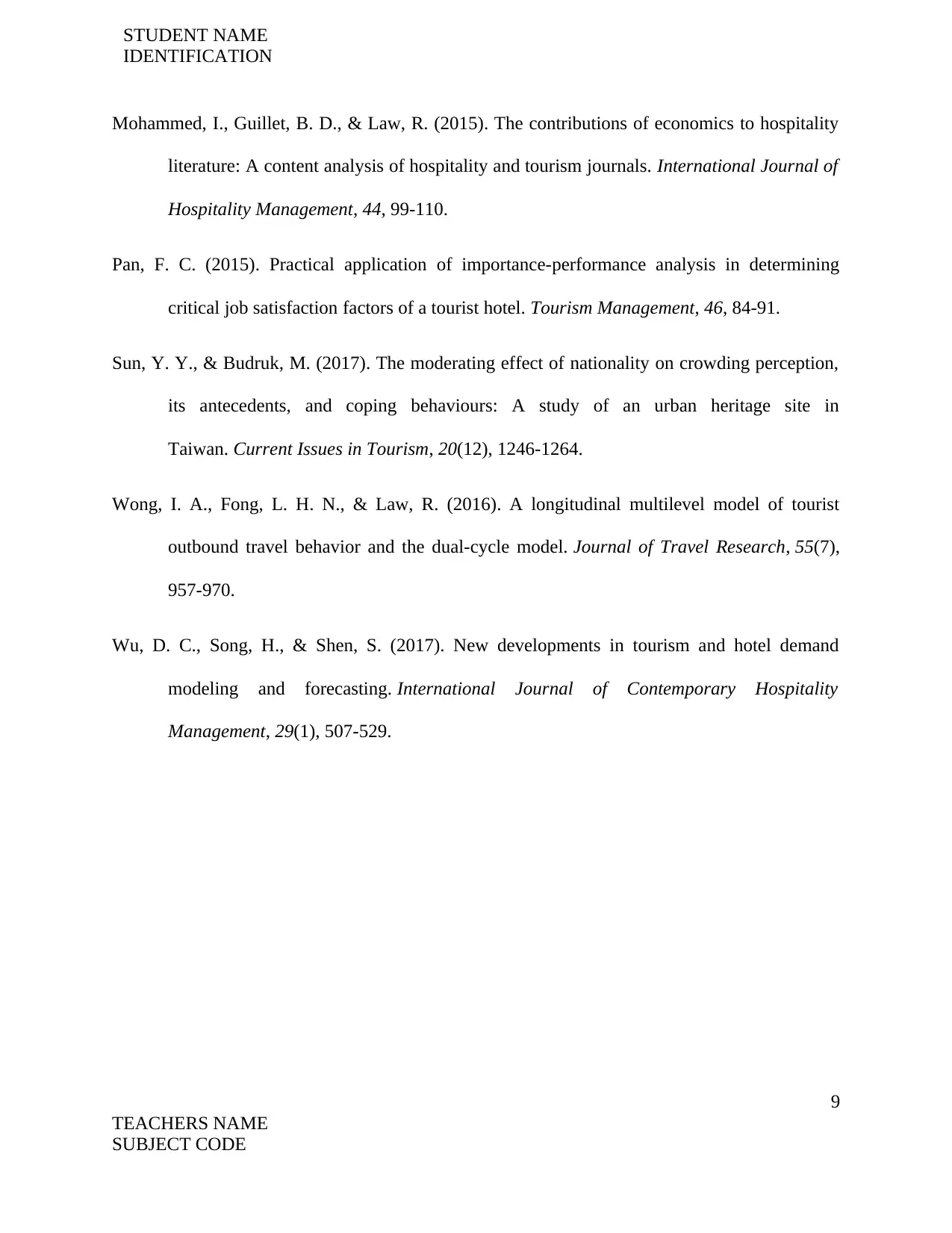
STUDENT NAME
IDENTIFICATION
Mohammed, I., Guillet, B. D., & Law, R. (2015). The contributions of economics to hospitality
literature: A content analysis of hospitality and tourism journals. International Journal of
Hospitality Management, 44, 99-110.
Pan, F. C. (2015). Practical application of importance-performance analysis in determining
critical job satisfaction factors of a tourist hotel. Tourism Management, 46, 84-91.
Sun, Y. Y., & Budruk, M. (2017). The moderating effect of nationality on crowding perception,
its antecedents, and coping behaviours: A study of an urban heritage site in
Taiwan. Current Issues in Tourism, 20(12), 1246-1264.
Wong, I. A., Fong, L. H. N., & Law, R. (2016). A longitudinal multilevel model of tourist
outbound travel behavior and the dual-cycle model. Journal of Travel Research, 55(7),
957-970.
Wu, D. C., Song, H., & Shen, S. (2017). New developments in tourism and hotel demand
modeling and forecasting. International Journal of Contemporary Hospitality
Management, 29(1), 507-529.
9
TEACHERS NAME
SUBJECT CODE
IDENTIFICATION
Mohammed, I., Guillet, B. D., & Law, R. (2015). The contributions of economics to hospitality
literature: A content analysis of hospitality and tourism journals. International Journal of
Hospitality Management, 44, 99-110.
Pan, F. C. (2015). Practical application of importance-performance analysis in determining
critical job satisfaction factors of a tourist hotel. Tourism Management, 46, 84-91.
Sun, Y. Y., & Budruk, M. (2017). The moderating effect of nationality on crowding perception,
its antecedents, and coping behaviours: A study of an urban heritage site in
Taiwan. Current Issues in Tourism, 20(12), 1246-1264.
Wong, I. A., Fong, L. H. N., & Law, R. (2016). A longitudinal multilevel model of tourist
outbound travel behavior and the dual-cycle model. Journal of Travel Research, 55(7),
957-970.
Wu, D. C., Song, H., & Shen, S. (2017). New developments in tourism and hotel demand
modeling and forecasting. International Journal of Contemporary Hospitality
Management, 29(1), 507-529.
9
TEACHERS NAME
SUBJECT CODE
1 out of 10
Related Documents
Your All-in-One AI-Powered Toolkit for Academic Success.
+13062052269
info@desklib.com
Available 24*7 on WhatsApp / Email
![[object Object]](/_next/static/media/star-bottom.7253800d.svg)
Unlock your academic potential
Copyright © 2020–2025 A2Z Services. All Rights Reserved. Developed and managed by ZUCOL.





